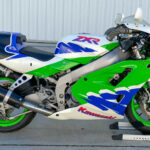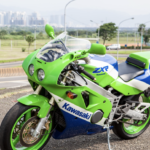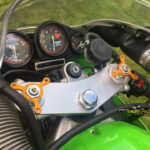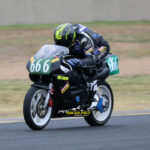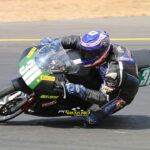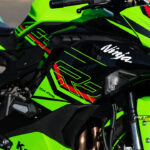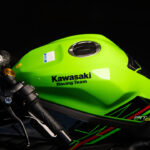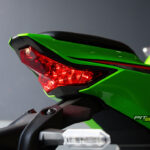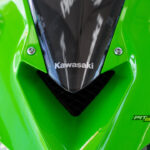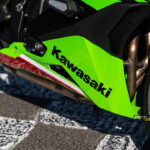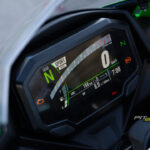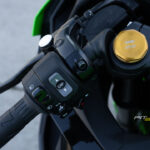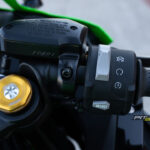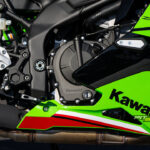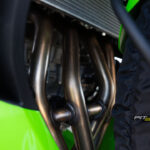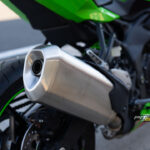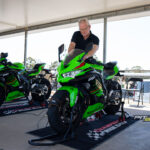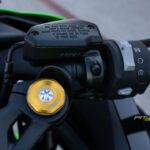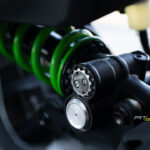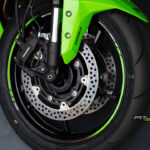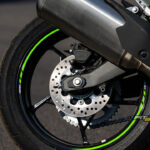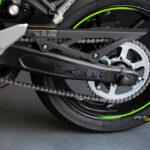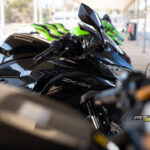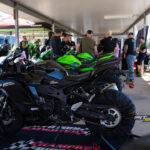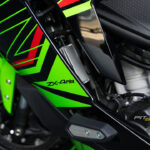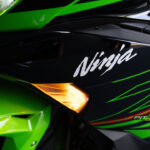There is no denying that a non-lams approved, small capacity, high revving four-cylinder sportsbike is an incredibly niche market. But, goodness, we are glad Kawasaki brought the new Ninja ZX-4RR & ZX-4R to Australia. How does it handle hitting the track though? Words: Zane Dobie
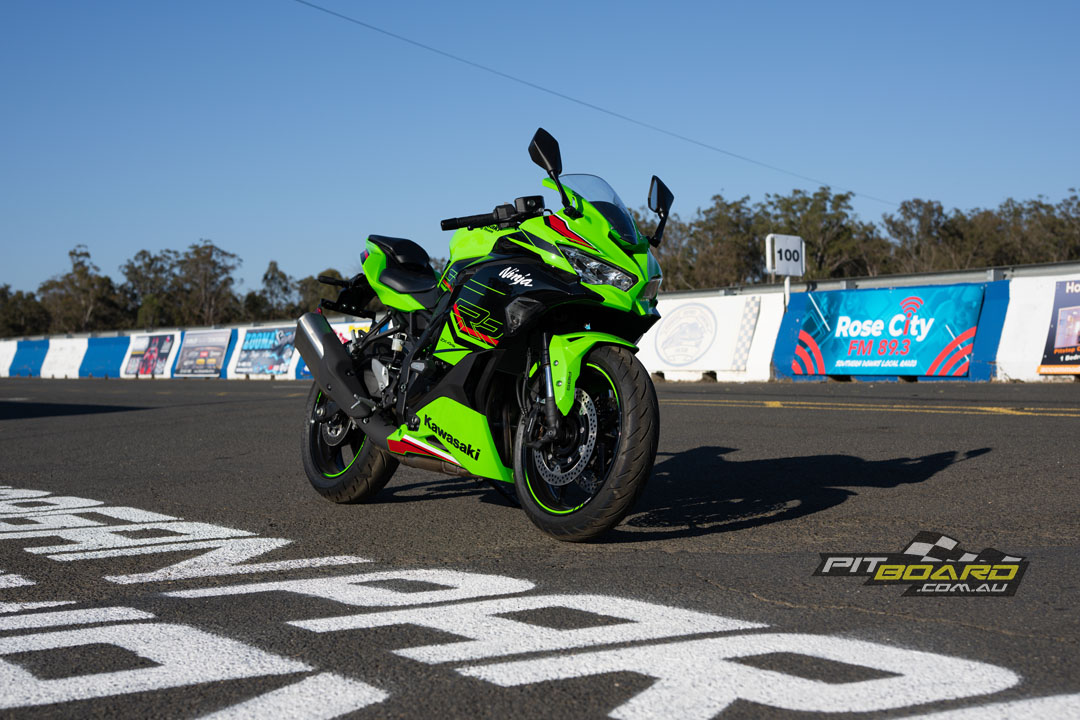
We haven’t seen the likes of a bike like this since the ZXR400 production stopped in 1999; sure, you could buy a CB400 in Australia up until 2012, but nothing could compare to the fully-faired high-revving machines of the ’90s.
Even when the ZXR400 finished production, it was pumping out 48kW@13,000rpm (homologation model) and a top speed of 225km/h! In 1999! The inline-four 398cc wasn’t a popular choice. Many people opted for the larger counterparts, but if you owned a 400, the chances are you knew how to really extract the most amount of performance a motorcycle can give.
Back then, the mini supersport models got all the cool bits. The ZXR400 had a 16v head with tiny 32mm flatslides, adjustable cams and a rev limit of 15,200rpm on the homologation models. The frame was fitted with adjustable front and rear suspension, a single seat and a lighter rear sub-frame.
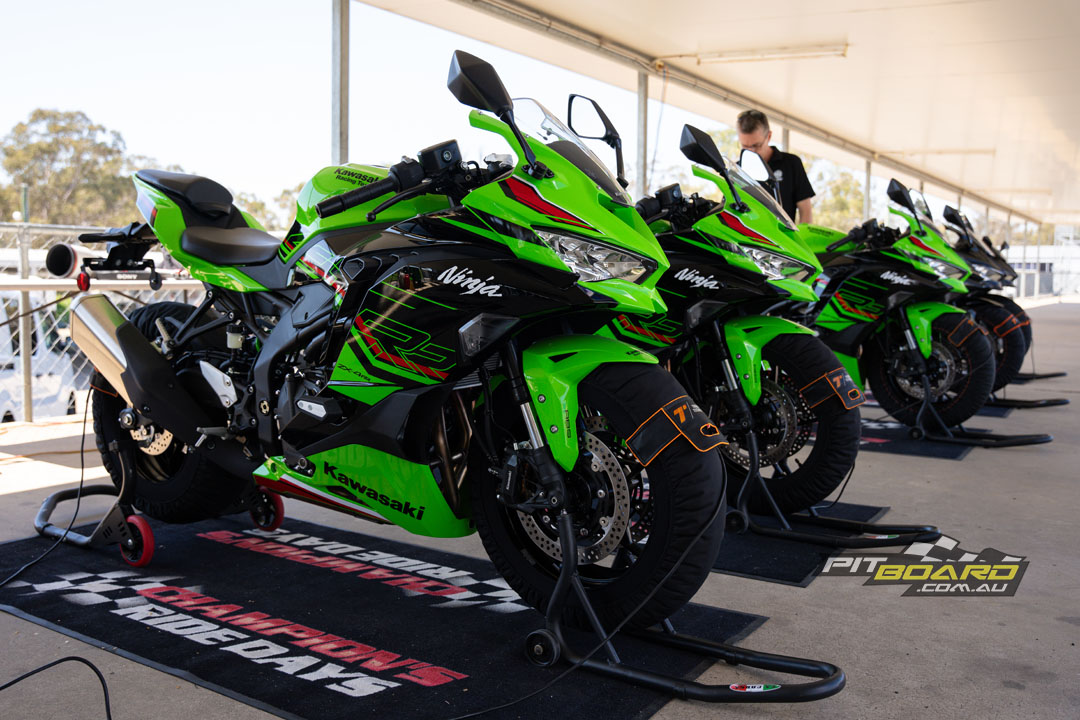
They didn’t make these bikes as an affordable entry into the brand; they were a race bike with premium equipment for the road. In a world where the lower capacity motorcycles get some average, low-spec suspension and dismal powerplant, Kawasaki has said “screw that” and made the Ninja ZX-4RR.
” In a world where the lower capacity motorcycles get some average, low-spec suspension and dismal powerplant, Kawasaki have said “screw that” and made the Ninja ZX-4RR.”
I have a tremendous amount of love and respect for these bikes, having raced in the PCRA on multiple CBR250RR MC22s. There’s just something so rewarding about keeping a low-powered bike up around the 20,000rpm mark that forces you to carry some outrageous corning speed.
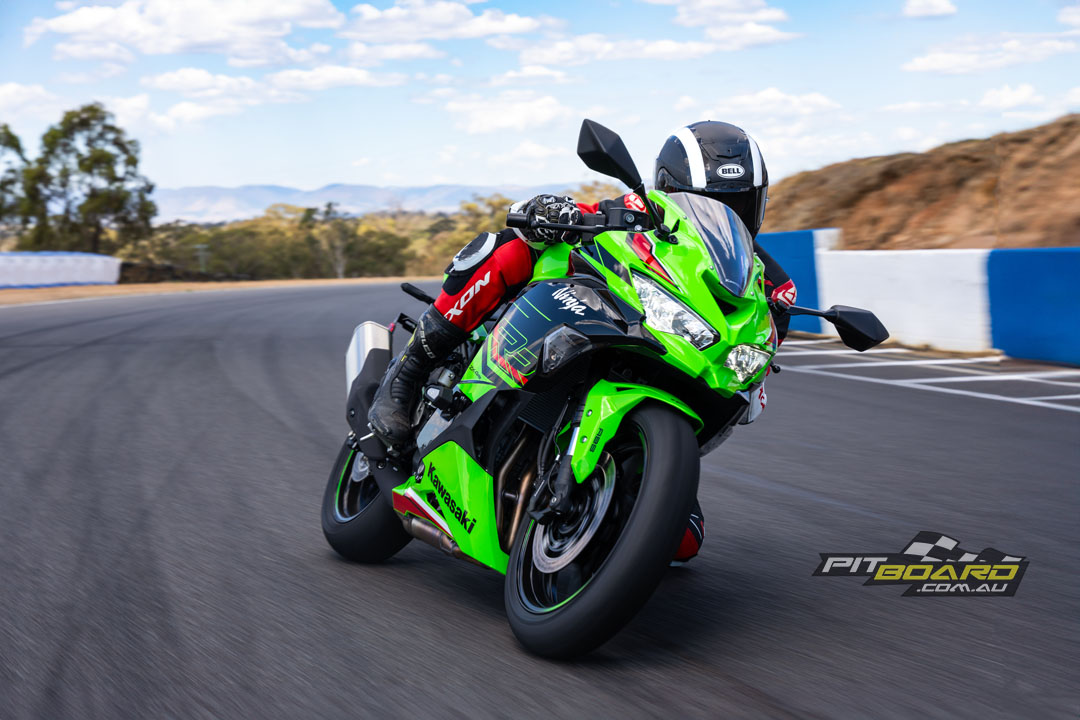
Not only would I be able to embarrass litre bikes (who think that just because their bike makes 200hp, it qualifies them for the race group) through the corners, but I would also be able to give the Supersport 300 riders a run for their money.
These bikes are simply the best sort of bikes to learn how to be early on the brakes and then quickly off them, diving the bike into the corner and not relying on torque to correct your mistakes, at least since the demise of two-stroke 250s. When Kawasaki released the ZX-25RR in 2020, I was distraught at the fact it wasn’t coming to Australia, so I held my breath with the announcement of the Ninja ZX-4RR.
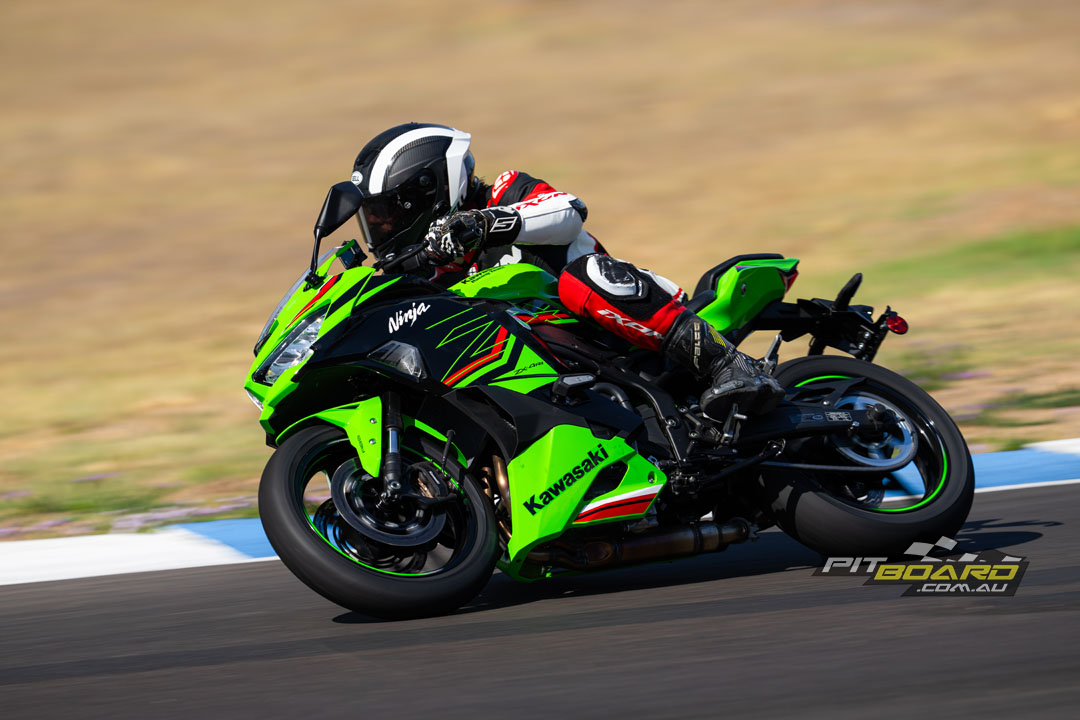
But here we are at Morgan Park with a green machine in front of me that surely promises to be one of my favourite bikes of the year, and what better place to see if it stacks up to its ’90s predecessors than on a race track.
Let’s chat styling first. The Ninja ZX-4RR is just a slightly scaled-down ZX-6R; it’s the opposite of a sleeper, which is what we so desperately need in this category. For those who don’t know what a sleeper is, it’s something that looks slow but is extremely quick. The headlights have been enlarged over the ZX-6R, but it still features that gorgeous and sharp fairing with the Kwaka ram-air intake.

The Ninja ZX-4RR comes in the KRT livery, while the ZX-4R will land in Australia in a sleek black. The KRT livery is the only thing that separates the RR from the R in terms of styling. LED lighting all around and a surprisingly solid tail section with no aero, sturdy mirrors mounted to the fairing and integrated indicators round out the look.
The Ninja ZX-4RR is deceptively small; it looks like a big bike from the outside, and my 183cm frame feels cramped almost instantly after throwing a leg over the bike for the first time. The bike is made to feel smaller than it is due to the choice of seat position; the bike feels a lot shorter and doesn’t have that typical tail rake that the 600cc Supersport and 1000cc bikes have. It’s actually a lot closer to a nakedbike rider triangle.

What’s the difference between the RR and the R? The RR gets a quick-shifter, preload adjustability on its SFF-BP Showa USD Forks (both models get SFF-BP forks), and a fully adjustable BFRC shock over the preload adjustable only on the single R. Other than that, the bikes are identical.
You’re met with a gorgeous 4.3in full-colour TFT dash that can be connected via Bluetooth to your phone for the typical Kawasaki Rideology app. You can access the two power modes (Full and Low), KTRC levels and rider profiles. The TFT can also be switched into a track mode, which includes a lap-timer and only shows you the tacho above 10,000rpm.
“Making its peak torque of 37.6Nm@12,500rpm, you can bet it has a seriously forgiving nature if you accidentally give it too many revs while releasing the clutch.”
The closest chance I have to testing how the ZX-4RR handles daily road riding is how well it takes off from a standing start in the pits. Making its peak torque of 37.6Nm@12,500rpm, you can bet it has a seriously forgiving nature if you accidentally give it too many revs while releasing the clutch. Riding through the pits proves the new Ninja easy to ride at slow speeds, and the throttle input is plenty smooth at speeds of 40km/h and lower!
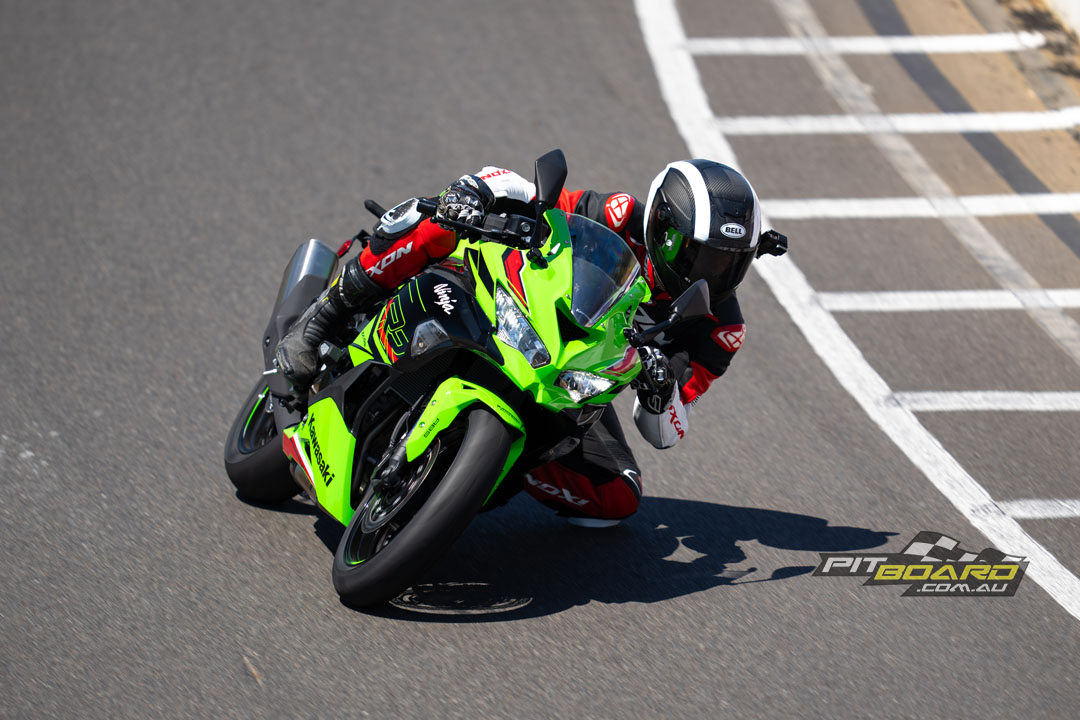
Exiting the pits for my first ever time at Morgan Park, and the ZX-4RR is set on Full Power and KRTC set on 1 (the lowest intervention), it’s time to hear this thing scream. Winding the throttle on, there’s that familiar feeling that reminds me of my first ever time on a racetrack on my MC22, zero feeling of torque and a smooth application of power as the tacho climbs until it reaches a whopping 16,000rpm.
Half a lap scrubbing in the tyres, I already have the Ninja cranked with my knee on the ground. There have been very few bikes in recent years that have inspired me with so much confidence to instantly put the hammer down and start pushing the bike to its limit. In fact, the last bike that did this to me was the little Yamaha YZF-R15M.
“There have been very few bikes in recent years that have inspired me with this much confidence to instantly put the hammer down and start pushing it to the limit.”
This bike isn’t scary by any standards. The four-cylinder 399cc powerplant is more than happy to be ridden way below the redline or bouncing off its max rpm. Early on, I realise that the ZX-4RR does feel like it’s lacking a few ponies compared to its claimed 56.7kW@14,500rpm, this most likely due to the deceptive nature of a high rpm torque and power peak, but it’s further away in feeling to a 600 Supersport than initially thought.
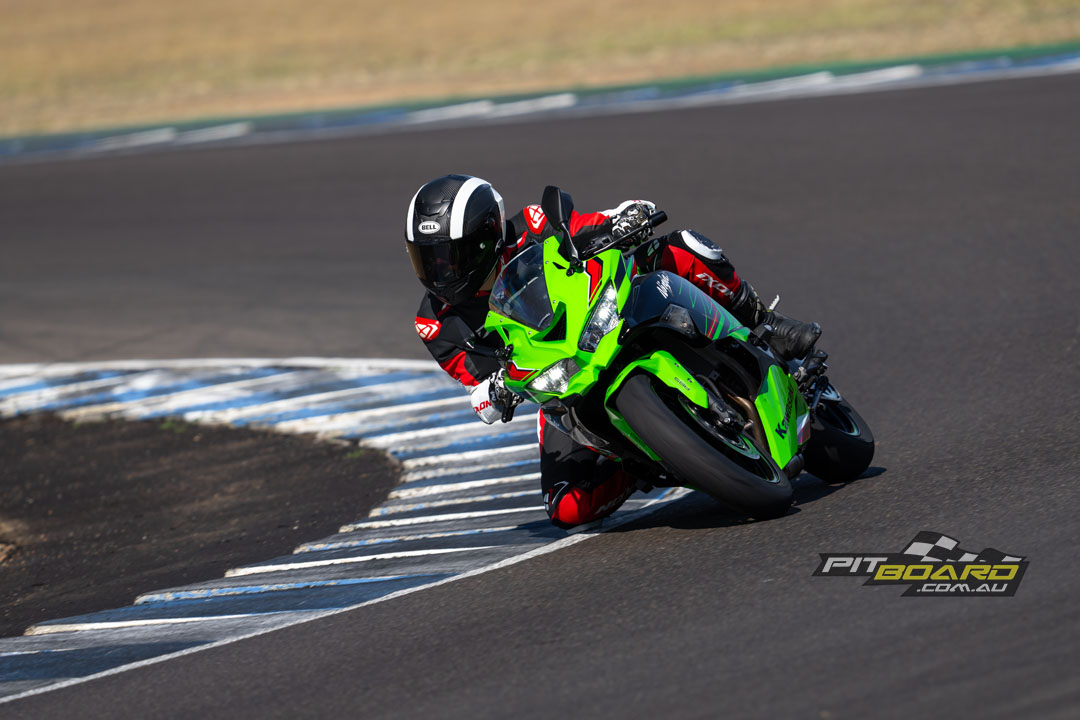
Bouncing it off the limiter, the bike feels like it has more to give in terms of power. I’m interested to see what can be done with these on the dyno if the limiter was raised another 1000rpm and the timing changed. I can’t wait to hear one of these with an aftermarket exhaust.
There are glimmers of that four-cylinder symphony, but that Euro-regulated muffler heavily muffles it. It whispers one of the loveliest sounds of a sub-700cc bike on the market at the moment.
The ZX-4RRs were fitted with Dunlop Sportsmart TT and had tyre warmers thrown on in between sessions as opposed to the Dunlop Sportmax’s that are fitted from factory. I’d say this is an essential upgrade for anyone looking to extract the most performance out of the RR on the track; it helps keep up with that sporty suspension and get the most out of that side grip.
After a few more sessions, I begin to get my eye in and push the Ninja ZX-4RR to its limit; this is when I find a few things on the suspension that need to be changed to suit my riding style. The factory settings compressed far too quickly under hard braking, which causes the bike to lift the rear wheel and become unstable into the corner.
We click the front preload up two steps harder, then four more after that when I begin to see some further stability whilst entering the corner.
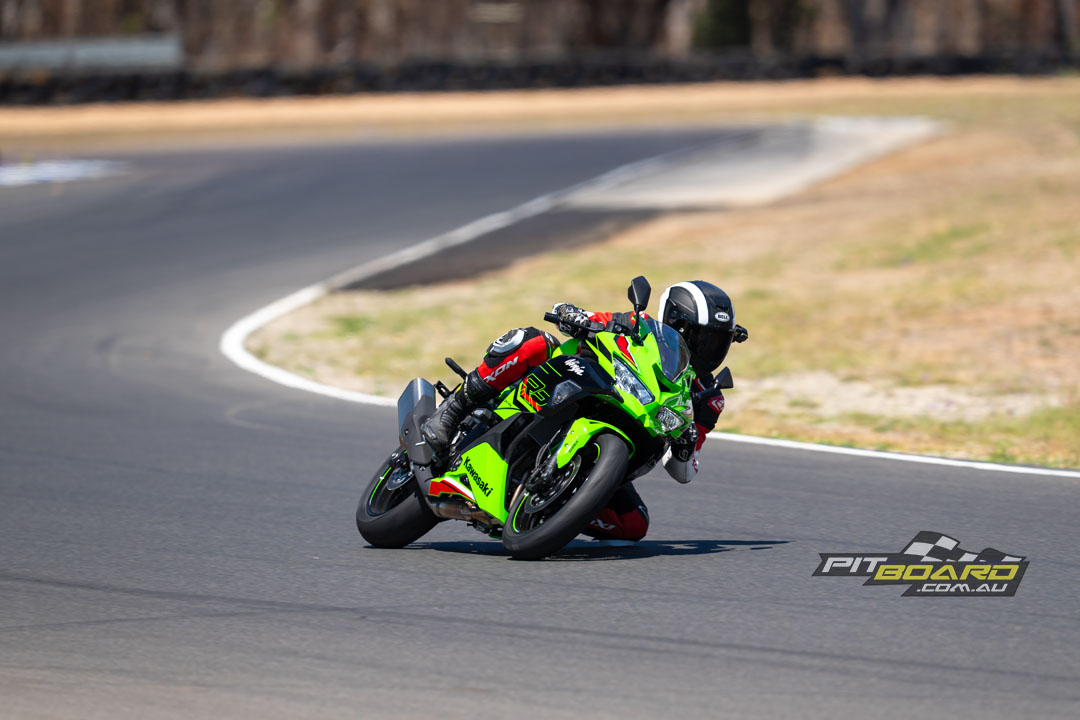
On the RR, the rear shock felt suitable for my 85kg frame. A lack of torque helped limit the corner exit squat coming back onto the throttle. With these small, high-revving machines, you need to be on the throttle as soon as possible when you reach the other side of the corner.
I notice the TCS light flashing on corner exits, so some changes to the shock settings to help that rear tyre grip up better may have helped me get on the throttle earlier.
“You can tell they’ve taken some design queues from the ZX-10RR with the frame; it’s just excellent. Everything feels so planted, the ZX-4RR just goes precisely where you tell it to go.”
As the day heated up, I’m still pushing the RR as much as my body will let me. I find the bike getting unsettled while lifting slightly through the long turn three sweeper. A possible revision of the rebound setting helps with the rear tyre losing grip while releasing some of the weight off.

You can tell they’ve taken some design queues from the ZX-10RR with the frame; it’s just excellent. Everything feels so planted, and the ZX-4RR just goes precisely where you tell it to go. The side changes are lightning fast thanks to a wheelbase of just 1380mm, but it also maintains its mid-corner stability well with some of those 170km/h corners at Morgan Park.
The brakes are excellent. After riding those ’90s 250s for so long, I’ve become accustomed to squeezing the brakes as hard as possible, coming into a corner to try and slow up a little. The ZX-4RR, on the other hand, encouraged me to use fewer brakes and come off them much earlier than I would with other bikes.
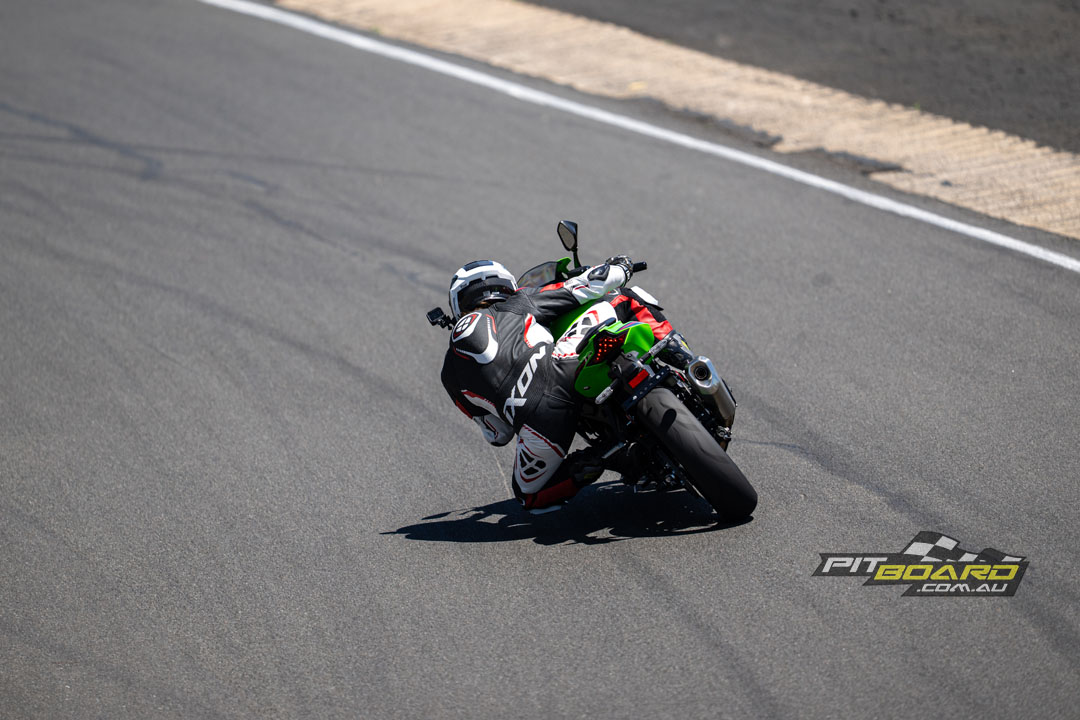
The initial bite is plentiful, I feel more confident to squeeze them on all the way than I would on other bikes. They’ve matched the weight and size of these with an excellent brake package that isn’t going to send you over the ‘bars when you grab them. It should also be worth noting that at no time did I feel the brakes begin to fade or lose any braking power throughout the day; this is on factory brake pads!
The quick-shifter is excellent on the upshift with the RR; it helps you focus on your line and stay in that top-end powerband. The downshift is average in terms of an up-and-down quick-shifter; it needs a slight blip to really smooth out the shift.

In terms of gearing, I didn’t find my way above fourth gear on the Morgan Park circuit. I feel like it’s much of a location thing if you’re taking one of these on track, across the board, it could use an extra tooth on the front and rear sprockets; the acceleration feels a little lazy with someone like me on board.
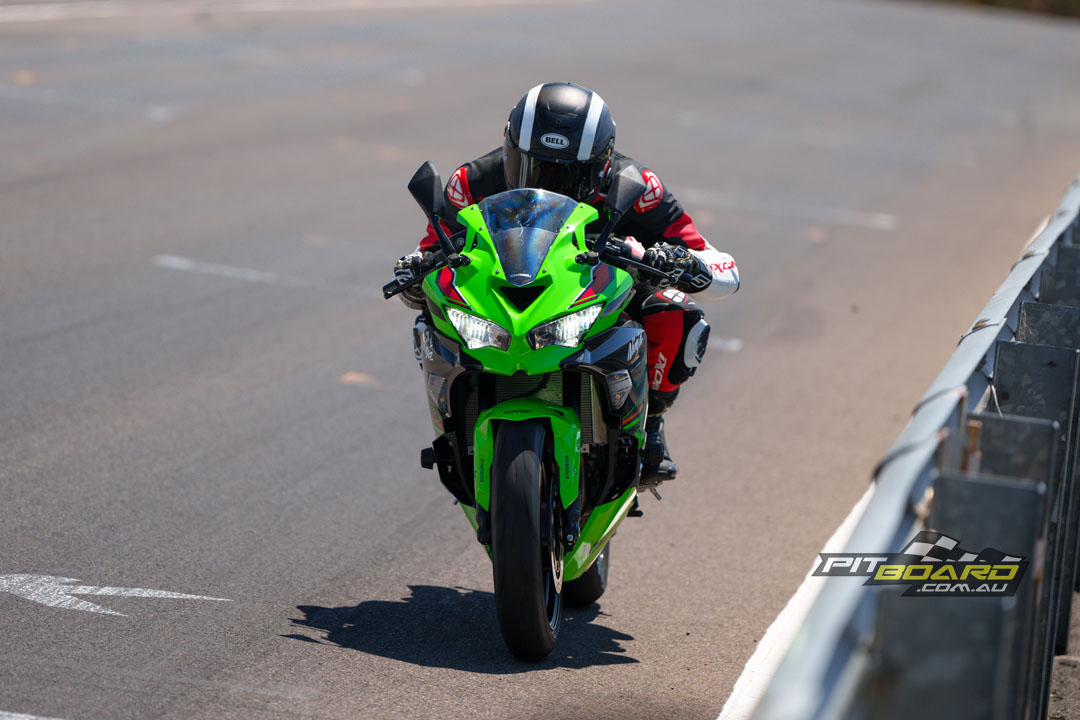
Just quickly touching back on those ergonomics, while in a slipstream position, my elbows do touch my knees, making me feel claustrophobic on the bike and out in the breeze. I could have hit 195/200km/h if I could have tucked in properly. The seat height and footpeg location would be the first on my list to change, but for people under 177cm, it would work really well. I can see this rider triangle working really well for street riding.
Ninja ZX-4R
After a few sessions on the RR, I decide to try the single R for a few laps. The single R was fitted with the standard Dunlop Sportmax hoops, so I ride with a little more caution than I was with the RR. It turns out there’s no need, as the R provides just as much instant confidence to put the hammer down.
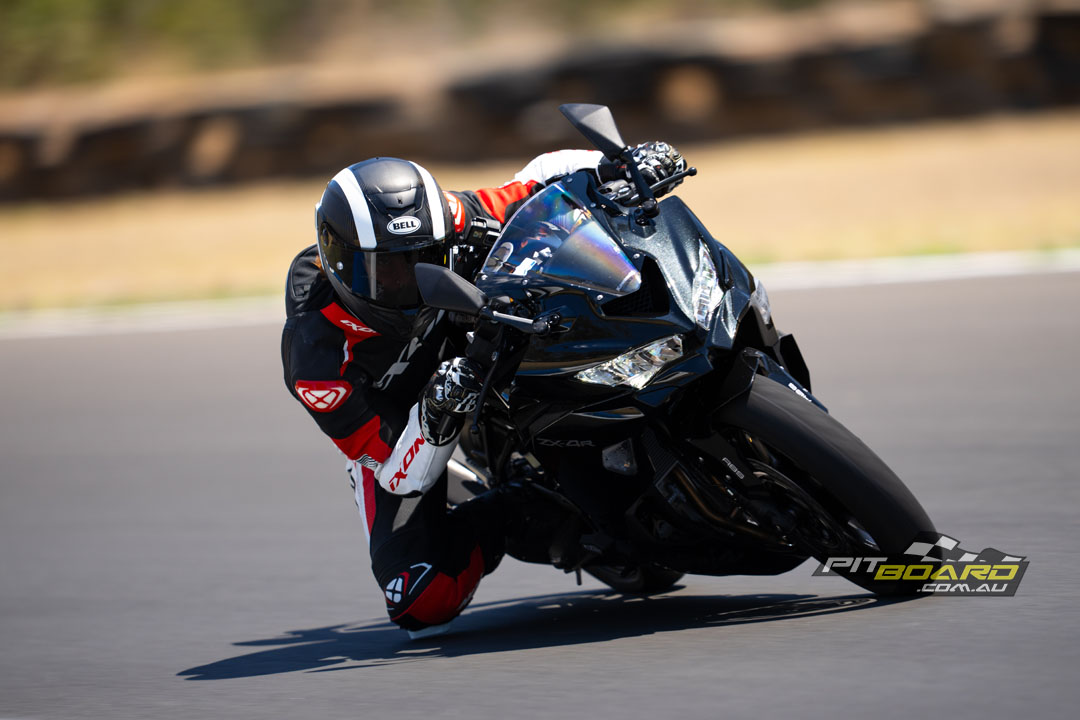
I almost feel like the stiff nature of the non-adjustable SFF-BP forks and the simple shock suit my weight and riding style better than what the RR was set to. There’s less dive in the front, and the rear feels planted despite not having the same grip level with the road bias tyres.
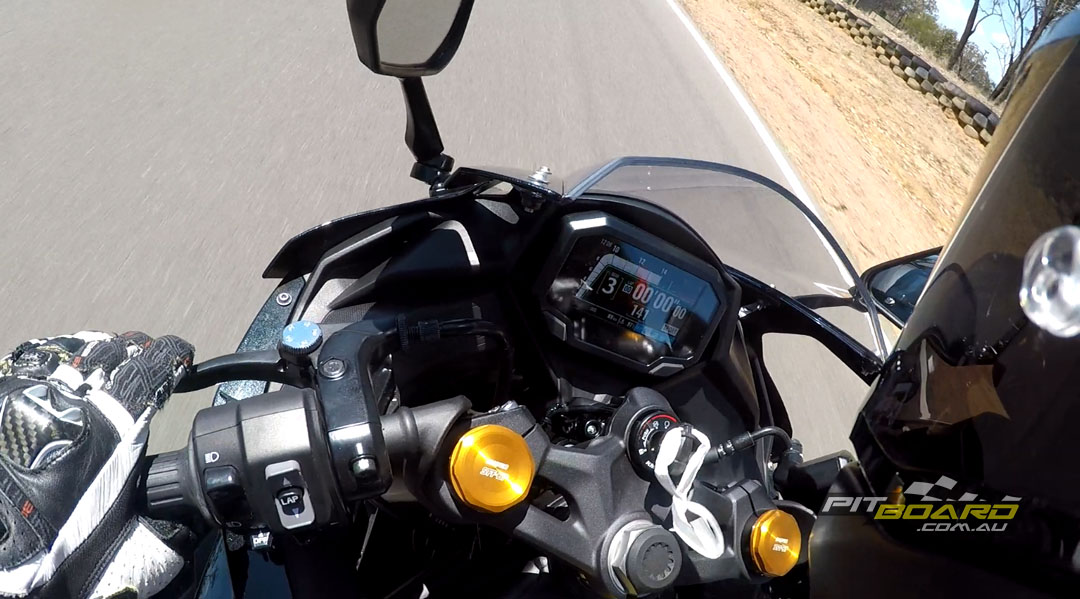
The road tyres make the R even twitchier and easier to change direction on than the RR on the TTs. Off the showroom floor, this thing is ready to boogie through your local twisties. The lack of a quick-shifter on the R is enough to make me want to throw myself back on the RR though. You can’t extract that same level of smoothness out of this engine without having those lightning-fast gear shifts.
ZX-4RR vs ZX-4R
I would opt for the Ninja ZX-4RR every time. You get an excellent level of equipment straight out of the factory for a price of $13,194 + ORC, but the single R is undoubtedly worth considering at $11,794 + ORC if you can’t get your hands on a RR or just don’t like the green. If it comes down to it, you can always add the quick-shifter as an accessory and possibly even buy that fully-adjustable shock later.
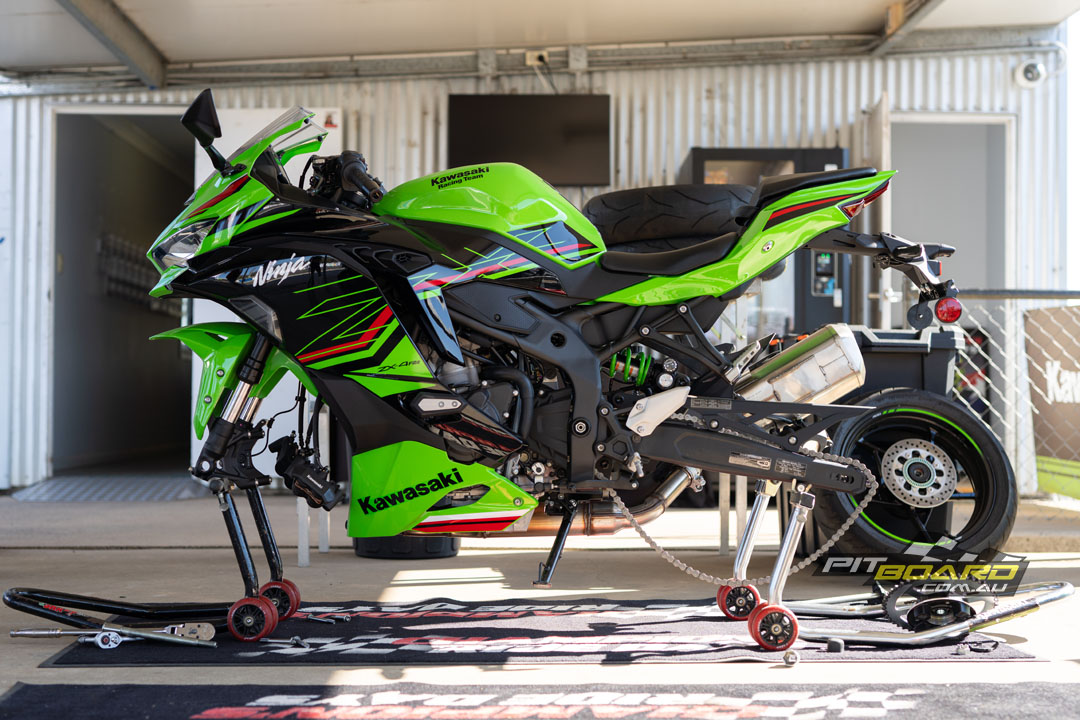
Kawasaki Australia have said they’ve only bringing in 80 of the RR and R combined for their first MY. You’re going to want to hit your local dealership before people realise they don’t need 200hp to have fun on Australian roads. But be quick!

This has been one of the only bikes in 2023 that I have seriously considered buying. The engine is so much fun and easy to ride, I see potential in the suspension being set up to my liking, and it’s a future classic. Kawasaki has done a fantastic job providing a base for a pocket rocket, and I’m praying that we will get to see an Australian race series for these. I’m also hoping that the other major manufacturers will soon follow this path of bringing back high-revving, low-capacity sportsbike for the general public.
For our full Tech Talk Details on the Kawasaki Ninja ZX-4RR, head here…
2023 Kawasaki Ninja ZX-4RR [ZX-4R] Specifications
Price: $13,194(+orc) [$11,794 (+orc)]
Warranty: Two-years unlimited km
Colours: KRT Lime Green [Spark Black]
Claimed Power: 55kW[75hp]@14,500rpm
Claimed Torque: 37.6Nm[43ft-lbs]@12,500rpm
Claimed Fuel Consumption: N/A
Wet Weight: 188kg
Fuel capacity: 15L
Engine: Liquid-cooled, in-line four-cylinder, four-stroke, 16-valve, DOHC, 399cc, 12.3:1 compression, 57 x 39.1mm bore x stroke, 4x34mm throttle bodies, wet sump.
Gearbox: Six speed with Kawasaki QS
Clutch: Wet, multiple disc slipper
Chassis: Trelis frame
Rake: 23.5°
Trail: 97mm
Suspension: 37mm USD Showa SFF-BP top out springs, preload adjustable [not adjustable on R] (f), Horizontal Back-link, BFRC lite gas-charged shock with piggyback reservoir, compression and rebound damping and spring preload adjustability, and top-out spring [Horizontal Back-link, gas-charged shock with spring preload adjustability] (r)
Brakes: Dual semi-floating 290mm discs, radial-mount, monobloc, opposed four-piston calipers (f) Single piston caliper, 220mm disc (r)
Wheels & Tyres: 120/70ZR17M/C (f) 160/60ZR17M/C (r) Dunlop Sportmax
Dimensions:
Wheelbase: 1990mm
Seat height: 800mm
Ground clearance: 135mm
Overall width: 765mm
Overall Length: 1990mm
Overall height: 1110mm
Instruments & Equipment: 4.3in TFT Dash, KRTC, Power Modes, LED Lighting, Kawasaki QS, ABS.


